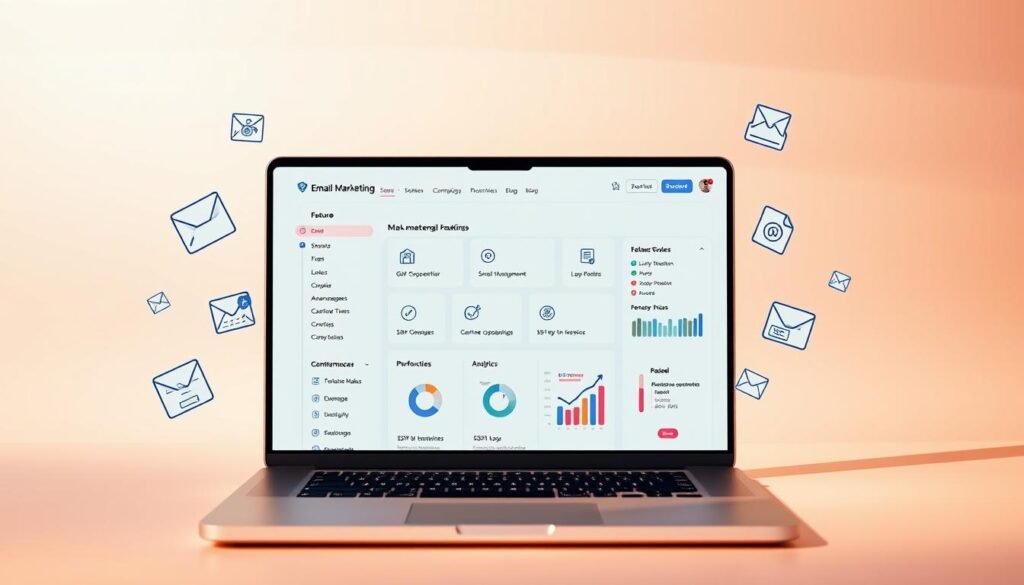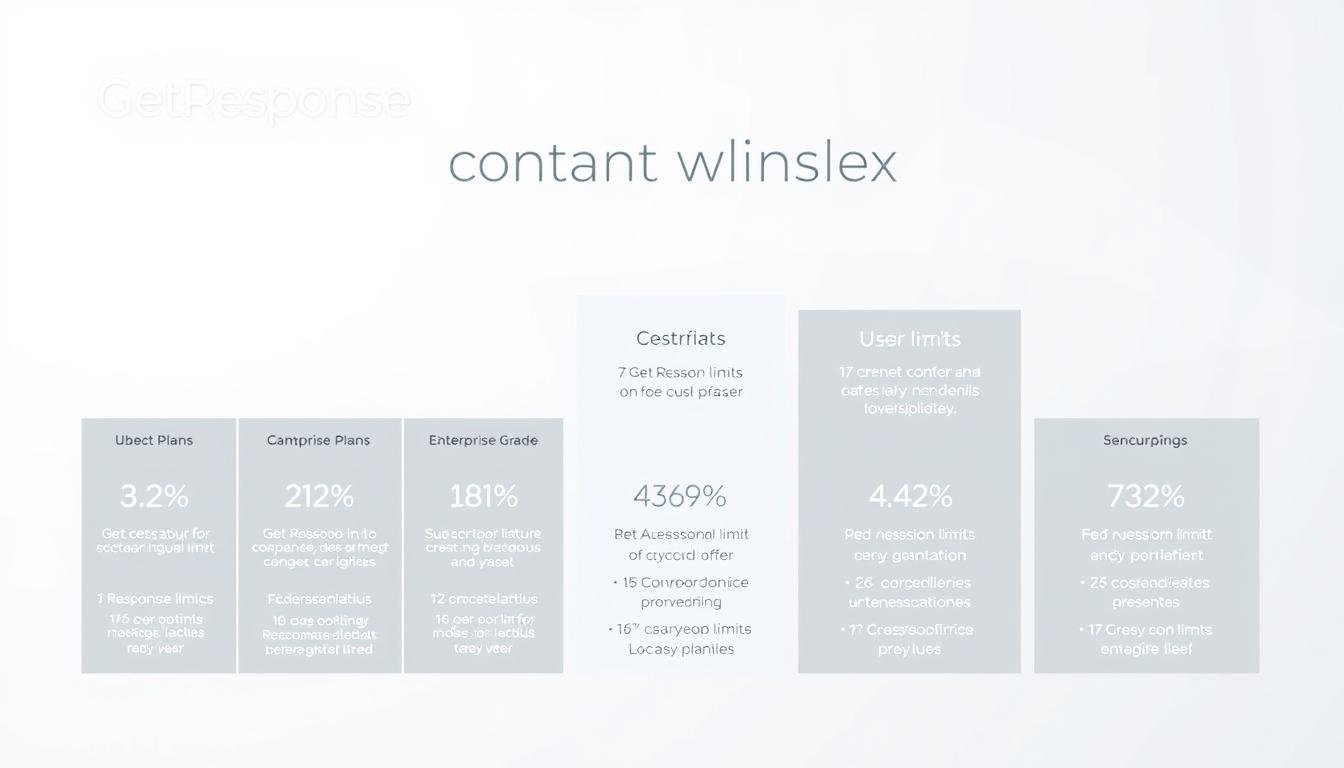Can one pricing chart decide your next marketing move?
This guide gives you a crisp, data-driven view so you can match budget to growth and ROI without guesswork. You’ll see how plans map to real business stages, which features matter, and where value hides.
The overview explains billing on active subscribers, why duplicates inflate totals, and how mid-cycle list growth bumps you to a higher level. We also flag annual and nonprofit discounts that change the effective price.
Expect clear examples of monthly bill changes as you cross thresholds. We compare Free, Email Marketing, Marketing Automation, Ecommerce, and Enterprise options so you can pick a marketing platform setup that protects conversion economics and fits your needs.
Key Takeaways
- Align plan choice with growth forecasts, not guesswork.
- Active subscribers are billable; duplicates across lists raise totals.
- Tier jumps can occur mid-cycle when lists grow.
- Compare features—automation, webinars, transactional sends—before upgrading.
- Annual and nonprofit discounts materially lower long-term price.
Buyer’s snapshot: who this guide is for and how GetResponse pricing works today
This snapshot helps growth teams weigh feature fit against long-term ROI, not just the cheapest sticker price.
Who should read this: growth-focused marketers, small businesses, and in-house teams comparing email marketing plans by value—not headline cost. By understanding the various offerings and features available, marketers can make informed decisions that align with their goals. A comprehensive getresponse pricing comparison can help identify the most cost-effective solutions tailored to diverse needs. This ensures that businesses not only maximize their budget but also leverage the best tools for their email marketing success.
Paid subscriptions bill per month at the highest active subscriber count during a cycle. Annual plans cut about 18% off your yearly spend, and nonprofits can get roughly 50% off.
Most paid plan tiers include unlimited emails. Higher levels add advanced automation, webinars, multi-user access, and ecommerce features that can boost revenue.
- Decide if Email Marketing covers newsletters and simple flows or if Marketing Automation will pay back the upgrade.
- Consider ecommerce triggers—abandoned cart and transactional emails—when revenue per user matters.
- Review support levels: 24/7 chat at lower tiers, with phone and priority support on enterprise.
We’ll use per month examples later to show when a higher plan reduces churn, increases conversions, and improves ROI as your list scales.
GetResponse contact limits and pricing tiers
Understand how subscriber counts translate into monthly bills so you can forecast costs precisely.
How contacts are counted
Billing uses only active subscribers. Unsubscribes, bounces, and deleted records do not add to your total.
Duplicate records on separate lists are billed multiple times. Clean and merge lists to avoid avoidable charges.
Per-month examples and thresholds
Pricing is set at defined thresholds: 1K, 2.5K, 5K, 10K, 25K, 50K, 100K. Below is a compact comparison across common plans.
| Contacts | Email Marketing | Marketing Automation | Ecommerce Marketing |
|---|---|---|---|
| 1K | $19 | $59 | $119 |
| 2.5K | $29 | $69 | $139 |
| 5K | $54 | $95 | $169 |
| 10K | $79 | $114 | $199 |
| 25K | $174 | $215 | $299 |
| 50K | $299 | $359 | $444 |
| 100K | $539 | $599 | $699 |
Mid-cycle growth and billing behavior
When you cross a threshold mid-cycle, the system bills at the highest active count reached that month.
Example: Email Marketing at 10K is $79. Hit 10,001 and the invoice moves to the 25K band ($174) for that cycle.
- Target 80–85% utilization per bracket to avoid surprise jumps.
- Document list hygiene and suppress duplicates to optimize spend under these tools.
- Watch pages and opt-in points—funnels can tip you into the next band faster than expected.
For a deeper review of how this affects real accounts, see our detailed review.
Free plan: what you can do before you pay
The free tier gives a practical sandbox for builders and basic email flows. Use it to confirm fit, not to run your full-scale marketing program.
What’s included
- Manage up to 500 contacts and send 2,500 emails per month to test deliverability and templates.
- Publish one website with 5 GB bandwidth plus a single landing page capped at 1,000 unique visitors.
- Capture leads with forms and one popup, and use the drag-and-drop builder for pages and email design.
Trialing premium features for 30 days
You unlock select premium features for the first 30 days, but expect caps. Webinars are limited to 10 attendees and platform branding remains.
- No dynamic segment filtering in workflows; plan basic welcome or thank-you sequences instead.
- Chat can be added to one landing page during the trial; full 24/7 support belongs to paid plans.
- Use this month to benchmark template speed, analytics, and the builder experience before upgrading.
Entry paid tier: Email Marketing/Starter for small businesses

For small businesses running newsletters, the entry tier provides core marketing tools and predictable monthly costs.
What it includes
- Unlimited emails, unlimited landing pages and visitors, plus a website builder and templates.
- Forms, popups, A/B testing, and basic automations like welcome, birthday, and thank-you flows.
- Basic segmentation, 24/7 chat support, and typically a single user seat out of the box.
This plan is priced by list bands: $19 at 1K, $29 at 2.5K, $54 at 5K, $79 at 10K, $174 at 25K, $299 at 50K, and $539 at 100K per month.
Best-fit use cases
- Weekly newsletters, simple promotional campaigns, and lead magnets with basic funnels.
- Event announcements and seasonal campaigns that rely on clear templates and consistent sends.
- Teams that need a low-cost, full-featured starter plan before investing in advanced automation tools.
How to maximize value
Use landing pages and forms to capture leads, then nurture with simple segmented emails. Integrate with common tools to sync contacts and trigger sends without custom development. Monitor month-over-month list growth and upgrade when you outgrow basic workflows.
Scaling up: Marketing Automation/Marketer features and value
When teams need behavior-driven nurture, the Marketing Automation plan unlocks workflow depth and real-time personalization.
Advanced automation lets you build workflows from scratch with triggers, filters, split paths, and event-based actions. Tag and score subscribers to surface intent and route high-value leads to sales fast.
Use dynamic segmentation and link or page-triggered automations to send timely emails that feel personal. These automations scale personalization without manual lists.
Webinars, push, and team access
Host a webinar for up to 100 attendees and attach nurture funnels to drive pipeline velocity. Push notifications and 3 user seats let small teams coordinate across five active websites.
Pricing realities as lists grow
The plan starts at $59 for 1K and rises to $599 at 100K subscribers. Evaluate when conversion lift offsets the cost of automation tools.
Who benefits
B2B teams and brands building behavioral journeys—cart recovery, upsell triggers, reactivation—see the most upside. If your data sits in multiple systems, integrate signals to power smarter marketing automation.
Ecommerce Marketing/Creator: revenue-driving features for online stores and creators

Designed for merchants and creators who need direct revenue lift, this plan combines commerce signals with content monetization.
The plan unlocks ecommerce must-haves: abandoned cart automation, transactional emails, and personalized product recommendations that boost conversion.
Automated promo codes can be unique and synced to purchases so you push offers at peak intent. Ecommerce tracking ties revenue to each journey, letting you attribute lift from creatives and automation.
Earnings and creator tools
Run revenue-generating webinars for up to 300 attendees, sell paid newsletters, and offer on-demand access to courses. Creators can monetize audiences with integrated fulfillment and simple subscription billing. In addition, creators can engage their audiences by hosting interactive Q&A sessions, fostering a sense of community while exploring home design ideas. By providing exclusive content and personalized experiences, they can enhance subscriber loyalty and drive higher revenue. This multifaceted approach allows creators to build sustainable income streams while showcasing their expertise.
Operations and integrations
Five users lets you assign store ops, marketing, and CRM roles while keeping governance across assets. Integrations with Shopify, WooCommerce, and Magento sync catalogs and ingest purchase events automatically.
- Combine push with email to recover sessions and reinforce limited-time offers.
- Use conversion diagnostics to refine cart-stage triggers and SKU-level response.
- Validate ROI through AOV lift, repeat purchases, and cart recovery rates.
Pricing overview
The plan starts at $119 per month for 1K, rising to $699 at 100K. Evaluate per month ROI from cart recovery and repeat revenue before scaling up.
Enterprise options: MAX and MAX2 for high-volume senders
For high-volume senders, MAX and MAX2 package governance, channels, and dedicated support into one enterprise offering.
- SMS automation with included credits and advanced marketing automation workflows for cross-channel sends.
- Webinar capacity—MAX supports up to 500 attendees; MAX2 scales to 1,000 for launches and global events.
- Dedicated IP options (availability varies) to protect deliverability and reputation.
- Phone support and priority support on MAX; MAX2 adds a dedicated Customer Experience Manager and priority across chat, email, phone, and Slack for critical incidents.
When to consider these plans
Choose MAX when your team needs multi-user access (about 10 users), phone-level support, and stronger governance for mission-critical campaigns.
Move to MAX2 when you require SSO, enterprise-grade API throughput, unlimited users, sandbox environments, and strategy consulting that aligns platform features to business KPIs.
- Use cases: complex teams, global brands, and regulated industries needing strict SLAs and IP control.
- Integrations: higher API limits let you connect CDPs, data warehouses, and custom tools without throttling.
- Commercial fit: expect custom pricing often beginning near $1,099/month, tailored to entitlements like SMS credits and consulting.
Bottom line: These plans deliver enterprise-grade features and white-glove support for high-volume marketing programs. If deliverability, governance, and strategic guidance matter, MAX2 is the most comprehensive option.
Smart budgeting: discounts, add-ons, and competitor context
Smart budgeting starts with upfront discounts and a clear view of add-on costs so your monthly spend matches expected ROI.
Discounts that lower your effective price. Annual commitments usually cut about 18% off list cost, while verified nonprofits can receive roughly 50% off. Locking a year reduces per month volatility during peak campaigns.
Add-ons that affect total cost
Factor common extras into forecasts. Webinars for Email Marketing run around $40 for 100 attendees or $99 for 500. Team seats add roughly $20 for the first five users, then $5 per additional seat.
Enterprise add-ons like AI product recommendations and transactional emails are typically quote-based on MAX plans. Include those when you scope enterprise budgets to avoid surprise spend.
How this stacks up vs. competitors
- Brevo often wins on sheer contact volume with low send frequency.
- ActiveCampaign matches automation depth; compare feature fit not just price.
- Mailchimp grows pricey at scale; MailerLite is budget-friendly but simpler.
Practical steps: align the tools you actually use with plan entitlements, model multi-quarter spend around big campaigns, and benchmark per month cost across vendors to cut total cost of ownership for businesses using email marketing platforms.
Conclusion
Pick the plan that fits the automations you will actually use over the next 6–12 months.
Start by mapping workflows to outcomes: rank marketing automation, webinar needs, landing and landing pages testing, and builder tools before you upgrade. Confirm the emails and email campaigns you will run each month so subscriber growth won’t trigger surprise band changes.
Keep lists clean to control billing and track subscribers closely. If your team needs more users or priority support, scope MAX/MAX2 early and request tailored getresponse offers.
Quarterly, revisit ROI: optimize automation, content, and pages to extract maximum value from your marketing tool and align spend with results.

